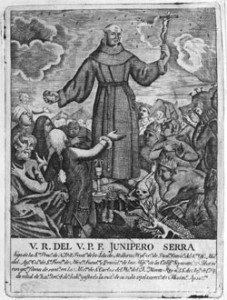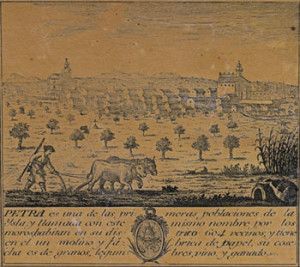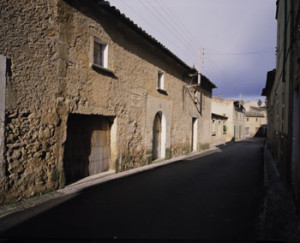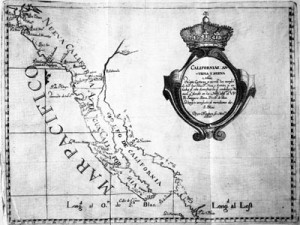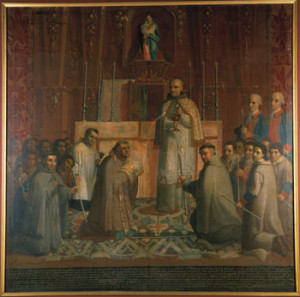In 1931, the statue of a man who stood only a bit taller than five feet and suffered from a chronically ulcerous leg was unveiled in the U.S. Capitol. This was Father Junípero Serra, a Spanish-born Franciscan, who in 1749 gave up a successful career as a priest and university professor in Mallorca and sailed to Mexico. There he became an apostolic missionary and worked to convert Indians to Catholicism. Twenty years after he arrived in Mexico, at the age of fifty-six, Serra was called on to play a crucial role in the settlement and colonization of Alta California, most notably as the architect of the chain of Catholic missions that eventually extended from San Diego to just north of San Francisco. More than eight feet tall, the Serra rendered in the nation’s Capitol stands much larger than life. His posture suggests a steady movement forward and over land. He wears a Franciscan habit, holds high aloft in his right hand a large cross and carries in his left hand a miniature replica of Mission San Carlos Borromeo, which he founded on the shores of Monterey, California, in 1770. This mission would be his home until his death in 1784.
On the day that Serra was memorialized in Statuary Hall, speaker after speaker extolled his piety, his tireless work among the Indians, and most important, his role as the “pioneer of pioneers” who brought civilization to California. He was lauded as the man who carried a message of salvation to the “uncharted shores of the Pacific,” and in particular he was credited with preparing the slopes of “this western land for the advance of empire which years later was to press on and fructify.” Serra did so, his supporters asserted, by bringing to California the key components of the Pacific agricultural empire: oranges, lemons, olives, figs, grapes, and vegetables, as well as cattle, sheep, goats, and horses.
To one degree or another, Serra did accomplish all of that. But today, as historians reexamine the historical development of the Pacific coast of North America, it is worth contemplating again Serra’s legacy. In the almost seventy-five years since the statue of Serra was unveiled, the man’s fame has only increased, even as his figure has provoked controversy, pitting celebrations against denunciations of his life and legacy.

I.
To millions, Serra is more than the founding father of what would become the state of California. To the Catholic faithful Serra is the saintly embodiment of timeless virtues: devotion, obedience, and charity. This religious memorialization of Serra began in his own day and took off in earnest just after his death. Upon the publication and circulation in 1787 of a hagiographic account of Serra’s life by Francisco Palóu, one of his fellow Franciscans, the saintly Junípero Serra joined a long line of missionaries whose virtues and sacrifices were chronicled and celebrated so as to stimulate enthusiasm among others for missionary life. In a woodcut included in Palóu’s Relación histórica de la vida y apostólicas tareas del venerable padre fray Junípero Serra, Serra stands above a sea of admiring worshipers. Throughout the nineteenth and early twentieth centuries, Serra remained the object of religious admiration in Spain, Mexico, and California. The Catholic Church accepted Serra’s cause for canonization in 1985 and declared him Venerable in 1986. Soon thereafter, Pope John Paul II beatified Serra before some thirty thousand pilgrims at St. Peter’s Square. Barring some unanticipated occurrence, the Catholic Church likely will canonize Serra and thereby create its first saint whose legacy is rooted in California and the American Southwest, presently the home of one-third of the nation’s thirty-one million Catholics.
Generations of critics of Spanish colonization have sketched a third Serra, one whose image inverts the portraits of Serra as pioneer and Serra as saint. To his detractors, Serra embodies an evil system that promoted cultural genocide, sanctioned corporal punishment, and initiated the demographic collapse of California’s Indians. For it is Father Serra whose name is most closely associated with California’s institutions of colonization, the missions where scores of thousands of Indians became enmeshed in an oppressive labor system and died prematurely of diseases, many of European origin. Standing alongside the heroic and saintly Serras of the Capitol and the Catholic Church is a villainous Serra with the worst features of Christopher Columbus, a man whose own life story is overshadowed by everything he has come to embody and symbolize to his detractors.
II.
Miguel Joseph Serra was born in 1713, in the town of Petra on the Mediterranean island of Mallorca. A community of only two thousand people, Petra’s rhythms, folkways, and institutions were those of early modern Europe. The home in which Serra was born and raised was a typical farmer’s house of the early eighteenth century: two stories, built of stone, with an entrance wide enough to serve the Serras and the family’s mule. Down the street, in the same block, was the parish church where the infant Serra was baptized the day of his birth.
Young Serra spent his early childhood working the family land with his father and attending a Franciscan primary school a stone’s throw from his home. These years were ones of political turbulence for the island of Mallorca, which had rejected the authority of Philip V, the first of the Bourbon monarchs to rule Spain. This resistance led to a loss of Mallorca’s local privilege, and Mallorca became a province of Spain, not an independent kingdom. Philip V may have been king of Spain, but his state’s presence on the island was weak, and what Mallorcans denied the monarchy in respect and power they granted to the Catholic Church. In the world of Serra’s childhood and youth, Catholicism therefore loomed large: it was a way of life, a way of ordering the world, the most powerful and pervasive institution Mallorcans knew. Serra’s own zeal for the preservation and propagation of the faith may have been honed early on as he came of age in a world where church and state distrusted one another and were locked in bitter controversy. During his seventeenth year, Serra joined the Franciscan Order; he chose for himself the name Junípero, inspired as he was by the life of St. Francis’s companion. The order Serra joined was a passionate defender of the Immaculate Conception, and it was dedicated to the teachings of John Duns Scotus and Ramón Llull.
It was not unusual for a promising young boy in Mallorca to take holy orders, but it was unusual for a man to give up the prestige of a university professorship and the security of the priesthood for the uncertain life of a missionary in the New World. Serra did so at age thirty-six, after spending more than a decade preaching throughout Mallorca and nearly as long teaching philosophy and theology at the Lullian University in Palma, the most important city on the island. Serra understood his commitment to a new life across the ocean as being for life. Serra was an extraordinary correspondent. His letters fill four volumes, but few ever went back to Mallorca. “With many people I could have kept up friendly relationships by letter,” Serra wrote. But, he continued: “If I was continually to keep before my mind what I had left behind, of what use would it be to leave it all?”
Serra went to Mexico in 1749, drawn by the scope and enormity of the challenge, and the chance the New World offered him to give freer reign to his ambitious spirit, which had begun to chafe under the authority of others. By and large his movement to the New World gave him autonomy—even as he lived the life of an obedient missionary under the Franciscan Rule. Within just a few years of his arrival in Mexico, he was elected by his fellow Franciscans as father president of the Sierra Gorda missions, chosen ahead of men who had decades of experience in Mexico. Clearly, it was not only Serra’s religious devotion that his peers valued or his abilities as a missionary but also his political skills, which in the rough-and-tumble world of colonial politics meant tenacity and clarity of purpose. It was these qualities that earned Serra the esteem and at times the wariness of his colleagues. Further, these skills brought Serra to the attention of his Franciscan superiors and the viceroy of New Spain, and led to Serra’s selection in 1767 as one of the chief architects and promoters of Spain’s imperial thrust into California.
In Serra’s California endeavors one sees a sudden expansion of energies to meet multiplying challenges and the deployment of an unusual constellation of qualities appropriate to the requirements of his new responsibilities. Clearly, in California—a land where the Spanish state had no entrenched interests and where the local Indians had no prior experience with Catholicism—Serra believed he had found a land and people that could be remade in the Lord’s image. Through the pieties and controversies that surround Serra and his legacy, one can still clearly see a man of extraordinary endurance, explosive energy, and unyielding determination, a man who placed his own mark on the heroic dimension of missionary life. In so doing he extended Spain’s imperial reach, protected the privileges of the Catholic Church, and ushered in a period of calamitous change for California’s Indians.
While Serra constantly distinguished himself through great constancy of purpose and clarity of vision, he was not a simple man, and his own character was replete with tensions, ironies, even paradoxes. Most of these emerged from the vows Serra took in becoming a Franciscan, promises that immediately set him apart from society even as they committed him to its reformation. Serra’s willingness to accept the oath of obedience to his superiors within the Franciscan Order gave him not only great powers over other missionaries who were obedient to him, but also allowed him a freedom from and even contempt for other hierarchical institutions, namely the Spanish monarchy. Serra believed in the nearly absolute powers of the church over the state, yet he lived in an age when the Bourbon state was increasing its authority over the Catholic Church. Serra in this sense was a mighty anachronism. Yet he was more than just a man swimming against the currents of history. Rather, he sought to reverse the rising tide of regalism that threatened to overwhelm his missionary order. In a further and more intimate irony, Serra sought to control Indians’ marriages and sexuality even though his own vows removed those roles and affairs from his own life. And finally, Serra believed with such certainty that his interpretation of Catholicism was the only path to salvation that he all too often proved uncompromising and alienated the very people he sought to convert.
III.
Serra lived a life in opposition to what California and the Pacific coast of North America would become: an economically dynamic region of diverse individuals, integrated into a global economy that transcends national boundaries. Serra’s distance from our age emerges clearly in a letter he wrote to his nephew in Petra in 1773. Serra wanted to give the young Miguel de Petra a sense of where his uncle lived. “Just get out a map of America and look at it,” Serra advised. “You will see on the coast of the South Sea, mistakenly called the Pacific Ocean, the California peninsula . . . Follow the coast to the north, and a little before it says Cape Mendocino, you will find on some maps the name: Port of Monterey. Well, it is there among these pitiful people that your uncle is living.” Serra’s insistence on Spanish imperial nomenclature—South Sea or Mar del Sur—not Mar Pacífico—is an indication of how he incorporated California into his Spanish worldview. In 1513, Vasco Núñez de Balboa, a Spaniard, named the vast ocean west of the Americas, the Mar del Sur. Seven years later, Ferdinand Magellan, a Portuguese sailing for Spain, called the same body of calm water Pacífico. Serra hewed to the term coined by Balboa, his countryman. Religiously, Alta California was a Spanish extension of the world of Roman Catholicism; its missions were administered by the College of San Fernando. Politically, Alta California was the northernmost frontier of New Spain; its military and civil life was overseen by officials who ultimately reported to a viceroy. Serra’s mission was to secure souls for the church and land for the Crown. Those who espoused faiths other than Catholicism were “pitiful people” to be converted or cast out; other Europeans—whose preference for different geographic names bespoke rival agendas or interpretations—had no place in Serra’s California.
California Indians, of course, challenged Serra’s religious and political vision at nearly every point—even as they struggled with the dire biological consequences of Spanish colonization. Throughout Serra’s tenure in California, no Europeans other than Spaniards set foot in the province. During Serra’s years as father president of the California missions (1769-84), the region was so isolated that it came to resemble the island that Europeans had long believed it to be. In 1781, the Yuma Indians severed Spain’s tenuous overland route from central Mexico to California. From then on California’s contact with Mexico would be by sea only. Serra himself expended no effort to find an economic staple that would make the colony profitable and therefore more valuable to the Crown. To have done so would have been to take time away from his attempts to win converts among the Indians. Moreover, a preoccupation with economic affairs would have amounted to an embrace of the materialism that his life and vows opposed. Serra was never a strong advocate of sending settlers to the region. Indeed, he was distrustful of them, believing that their bad conduct would delay the Indians’ conversion. It was only after his death that Spanish officials envisioned for a short while how to incorporate California economically into Spain’s imperial system.
IV.
Having arrived in New Spain in 1749 and settled in California twenty years later, Serra seems hardly ever to have looked back to Mallorca, his family, or his life across the Atlantic. But, ironically, his vision for California was inspired by an earlier age, a time when missionaries, Franciscans in particular, worked in isolated regions where the powers of the state were weak or nonexistent. Although he could not foresee California’s future, Serra and his fellow Franciscans did bring to the region many of the seeds of its eventual greatness. Yet, it was long after Serra’s death, after the passing of Spanish authority, the destruction of his mission system by secular forces, the privatization of the resources the missions had created and fostered over decades, the opening of the region to free trade, and its integration into the United States, that California would be set on a path of great economic and political power.
Thus, it is appropriate that as he stands in the U.S. Capitol, the seat of perhaps the most diverse and materialistic nation the world has known, Serra bears none of the trappings or symbols of California’s agricultural or economic empire. Rather, Serra holds aloft a large cross, the symbol of God’s empire. Serra stares at the cross like a determined navigator seeking his bearings and direction. He holds it high for all to see. Serra will follow wherever it leads. In 1784, Serra died, crucifix on his breast, in his sleep at Mission San Carlos. Today, more than two centuries later, Serra’s notoriety is secure. But the legacy of his missionary endeavors—just like the identity of the region he helped to settle—resists easy categorization, prompting debate and reinterpretation.
Further Reading:
Serra’s correspondence reveals his character as well as his relations with Indians, Franciscans, and military officials: Writings of Junípero Serra, ed. and trans. by Antonine Tibesar, 4 vols. (Washington, D.C,. 1955-66). The classic cradle-to-grave biography of Serra from a Franciscan perspective is Maynard J. Geiger’s The Life and Times of Fray Junípero Serra, O.F.M., 2 vols. (Washington, D.C., 1959). The original hagiography of Serra is Francisco Palóu’s Relación histórica de la vida y apostólicas tareas del venerable padre fray Junípero Serra (México, 1787). For a translation, see Palóu’s Life of Fray Junípero Serra, ed. and trans. by Geiger (Washington, D.C., 1955). On economic development in Spanish and Mexican California, see Steven W. Hackel, “Land, Labor, and Production: The Colonial Economy of Spanish and Mexican California,” in Contested Eden: California before the Gold Rush, eds. Ramón A. Gutiérrez and Richard J. Orsi (Berkeley, 1998). On Serra as a missionary and Indian life in the California missions, see Hackel, Children of Coyote, Missionaries of St. Francis: Indian-Spanish Relations in Colonial California, 1769-1850 (Chapel Hill, 2005). For the controversy of Serra’s canonization, see James A. Sandos, “Junípero Serra’s Canonization and the Historical Record,” American Historical Review 93 (Dec. 1988): 1253-69. Serra’s detractors: Rupert Costo and Jeannette Henry Costo, eds., The Missions of California: A Legacy of Genocide (San Francisco, 1987). For the practices and the ideology of Franciscan missionaries and priests in late-colonial Mexico, see Gutiérrez, When Jesus Came, the Corn Mothers Went Away: Marriage, Sexuality, and Power in New Mexico, 1500-1846 (Stanford, 1991); and William B. Taylor, Magistrates of the Sacred: Priests and Parishioners in Eighteenth-Century Mexico (Stanford, 1996).
This article originally appeared in issue 5.2 (January, 2005).
An associate professor of history at Oregon State University and author of Children of Coyote, Missionaries of St. Francis: Indian-Spanish Relations in Colonial California, 1769-1850 (Chapel Hill, 2005), Steven W. Hackel is writing a biography of Junípero Serra for Hill and Wang’s American Portraits Series.



